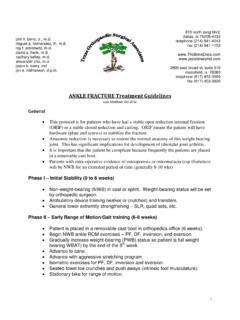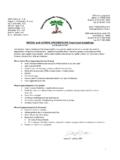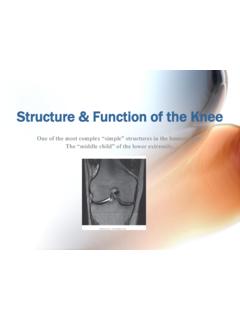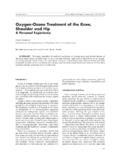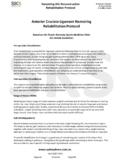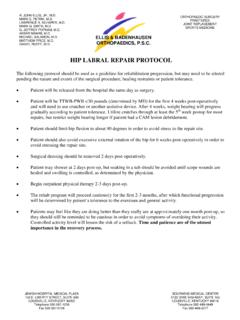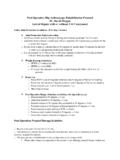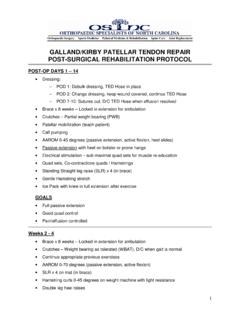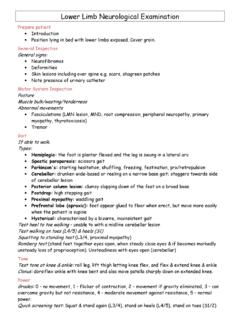Transcription of Total Hip Arthroplasty (Lateral Approach) Rehab Protocol
1 810 north zang blvd. dallas, tx 75208-4233. phil h. berry, jr., telephone (214) 941-4243. miguel a. hernandez, III, fax (214) 941-1153. ray f. aronowitz, david a. heck, zachary kelley, alexander cho, jason k. lowry, md 2800 east broad st, suite 510. jon e. nathanson, mansfield, tx 76063. telephone (817) 453-3500. fax (817) 453-3820. Total Hip Arthroplasty ( lateral approach ) Rehab Protocol (Last Revision: Oct 2012). General Goals: 1. Short Term (Week 1). A. Independent with exercises B. Independent with ambulation with assistive devices as needed a. Household distances b. Even and uneven surfaces (stairs). c. Weightbearing status determined by surgeon: generally WBAT. 1) Exception: intra-operative fracture or severe osteoporosis C. Independent with bed mobility and transfers D.
2 Independent with Total hip precautions 2. Long Term (Week 6)-Cemented; (Week 12)-Non-cemented A. Range of motion within functional limits to allow independence with activities of daily living (ADL's) ( dressing, bathing, transfers with adaptive equipment as needed). B. Sufficient strength to allow return to normal ADL's ( driving, aerobic exercise, use of regular height commode). C. Independent ambulation a. With assistive device as indicated b. Without gait deviation c. Household and community distances (1000'). d. On even and uneven surfaces General guidelines: The program will be individualized to the needs of the patients, specific pathology and pre/post-op condition. Patients non-compliant with home exercises will be treated in-clinic three times per week.
3 Rehabilitation will require ten to twenty visits. Cemented hips will generally be WBAT, progressing from walker to cane in a matter of weeks. Cane use may be up to 6 months. Generally, these patients are older and will have had an underlying fracture or have significant osteoporosis. Cane should be used in contralateral hand. Non-cemented hips (usually on younger THA patients) are tprotected weight bearing with a walker for 6 weeks. Wheelchairs should be used for long distances. The surgeon will prescribe weight-bearing status. Therapeutic Phases I. Preoperative A. Fit for walker and instruct in use B. Instruct in postoperative exercise program C. Instruct in Total hip precautions II. Postoperative A. Day 1-2 (Inpatient visit). 1. Transfer training (bed mobility, supine -> sit, sit -> stand).
4 2. Ambulation training with walker 3. Quad Sets 1. 4. Glute Sets 5. Ankle Pumps 6. Supine hip abduction/adduction (avoid going past neutral). 7. Review Total hip precautions B. Day 3-7. 1. Continue previous exercises 2. Straight leg raises as tolerated (check with surgeon on non-cemented hips). 3. Heel slides 4. Seated long arc quads, short arc quads 5. May also perform anterior capsule stretching of hip (to avoid hip flexion contracture) similar to Thomas test position, flex the uninvolved hip to chest 6. Continue gait training with weight bearing as tolerated (and as approved by orthopedics based on cemented vs. non-cemented) and progressing to cane or independent ambulation when able to ambulate without Trendelenberg gait C. Day 7+ (Cemented THA); 6 weeks + (Non-cemented THA).
5 - These are recommendations of safe exercises, patient does not have to perform every exercise listed. 1. Advance with previous exercises 2. Basic closed chain exercises (when full weight bearing on involved extremity). a. Concentrate on abduction to decrease/prevent Trendelenberg gait b. Total Gym Squats (0-45 knee flexion), toe raises c. Standing mini-squats (0-45 knee flexion). 3. Bridging 4. Standing 3-way leg raises (Hip flex, abd, ext). 5. Standing knee flexion 6. Standing toe raises 7. Seated BAPS board 8. Hamstring Curl Machine (hip precautions). 9. Leg Extension Machine (hip precautions). 10. Stationary bicycle (seat high to maintain hip precautions). 11. Advance to treadmill D. Recommended long-term activities after Total Hip Replacement (DeAndrade, KJ Activities after replacement of the hip or knee, Orthopedic Special Edition 2(6):8, 1993).
6 Very Good, Highly Good, Needs skill, prior With care, ask your AVOID. Recommended Recommended expertise doctor Stationary Cycling Bowling Bicycling (street) Aerobic Exercise Baseball Ballroom dancing Fencing Canoeing Calisthenics Basketball Square Dancing Rowing Horseback Riding Jazz Dancing Football Golf Speed Walking Ice Skating Downhill Skiing Softball Stationary (Nordic Table Tennis Doubles Tennis Handball Track) skiing Cross-country skiing Step Machines Jogging Swimming Weightlifting Nautilus Machines Racquetball Walking Inline Skating Lacrosse Downhill Skiing Soccer Singles Tennis Volleyball HIP PRECAUTIONS. Positional precautions: no hip adduction past neutral, no hip internal rotation past neutral, and no hip flexion >90. Adhere to these principles for a minimum of 12 weeks until soft tissue stabilization has occurred; however, hip flexion may increase >90 at 6.
7 Weeks. Certain surgical approaches may have special precautions, surgeons will inform patient and therapist. Abduction pillow: use the abduction pillow for the first 4 weeks while resting or sleeping in bed. Bathroom: use the elevated toilet seat at all times. Can be discontinued at 3rd month. Assistive Devices: Use ambulation devices (cane, walker, quad cane) as instructed by physical therapy. Reacher and grabber . devices to be used for retrieving objects on floor or assist with socks or stockings. Long shoe horn to be used with loosely fitting shoes or loafers. A kit can be provided to patient (if stocked). Transfers: Bed to chair: Avoid leaning forward to get out of chair to bed. Slide hips forward first, then come to standing. Use someone to assist patient until patient demonstrates safe, secure transfers.
8 Bathroom: Use elevated toilet seat with assistance. 2. Continue assistance until safe, secure transfers. NOTE: Throw rugs should be moved out of bathrooms, kitchens when using assistive devices to ambulate. In Vehicle: Can travel in the back seat of a 4-door sedan, sitting or reclining lengthwise across the seat, leaning on 1 or 2 pillows under head and back. Avoid sitting in conventional fashion (hips flexed more than 90 degrees) to avoid posterior dislocation of hip in the event of a sudden stop. If no 4-door sedan, then recline in front seat, but sit on 1 or 2 pillows. Driving: Usually at 6 weeks post-operatively. Jason K. Lowry, MD. 3.
